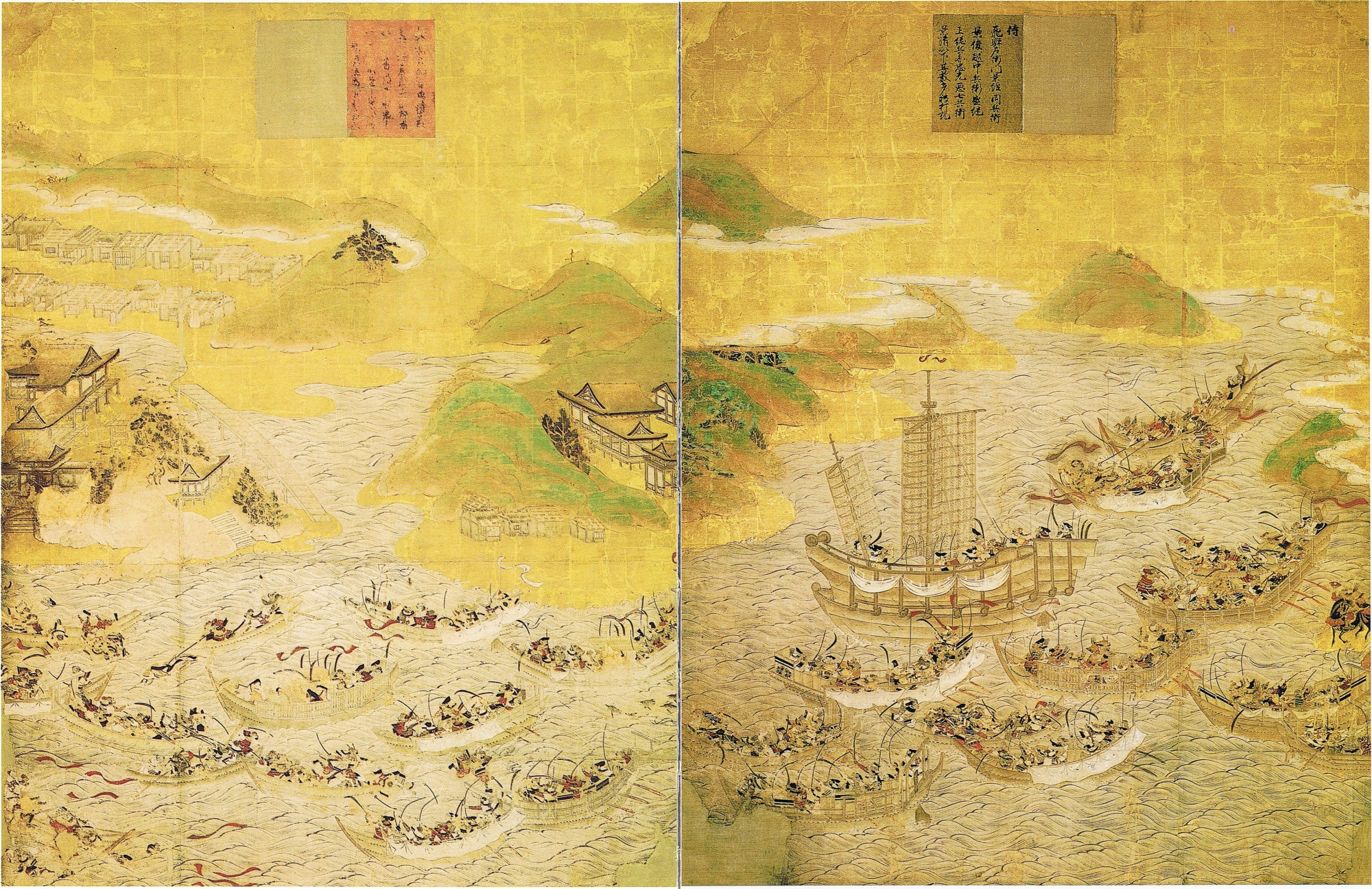
With the rise of the samurai class to a position of power Japan became split by the bitter fighting of the Gempei War, fought between the rival clans of Minamoto and Taira. Much use was made of ships in Minamoto Yoshitsune’s pursuit of the Taira through the waters of the Inland Sea, which finished with the greatest naval battle seen in the Far East up to that time: the Battle of Dan no Ura.
The background is as follows. By early 1185 the Taira clan had been driven from their bases on the main Japanese island of Honshu and the island of Shikoku, by a series of battles, such as the famous Ichi-notani and Yashima. In both these cases the Minamoto victory had been somewhat nullified because the Taira had escaped to sea. Their power base had traditionally been in the west of Japan and the Inland Sea, and they possessed a large fleet, but in the pursuit of them the Minamoto had also built and acquired ships, and were becoming well prepared to meet the Taira on their own terms. The Taira’s trump card was that they controlled the narrow straits of Shimonoseki, between Honshu and Kyushu, but by April 1185 the Minamoto felt strong enough to try to attack them, and actually had more ships: 840 to the Taira’s 500.
On 24 April 1185 the Taira fleet, under the command of Taira Tomomori, left its main base of Hikoshima island, which dominates the western approaches to the Shimonoseki Strait, and reached Ta-no-ura on Kyushu, a few miles east of the modern city of Moji. At the same time the Minamoto fleet slowly advanced to Okutsu island, which is probably the island called Manjushima today. The two fleets were then about two miles apart. On the 25th, off a beach named Dan no Ura (east of the modern city of Shimonoseki), the ships, brightly decorated with flags and streamers, approached one another, reducing the gap to about four hundred metres. The Minamoto fleet was upstream from the Taira’s.
We have some idea of the appearance of these war vessels through a large screen painting commissioned in the fourteenth century, but apparently based upon contemporary materials. One Taira ship was a large Chinese-style vessel with battened sails and a double hull, which was used as a decoy to fool the Minamoto into thinking that the child Emperor Antoku was on board. The other ships on both sides were small, clumsy, oar-propelled junks. They are referred to as war vessels, but they do not seem to have differed particularly in construction from ordinary ships, and were probably mainly fishing or ferry boats commandeered for the purpose. This is not of itself remarkable, for the major function of war vessels in those days was to bring two armies within bow range and then sword reach. Ships, in other words, were merely platforms for land warfare to be transferred to the sea, and had no defensive or offensive weapons of their own.
Neither fleet could boast any definite organisation. The officers and men were largely untrained in naval warfare, although the Taira had much more experience because for generations they had been entrusted with the task of clearing the pirates from the Inland Sea. Until Dan no Ura their naval supremacy was secure. The Minamoto fleet was numerically superior because many chiefs from Shikoku and from the provinces of Suo and Nagato in south-western Honshu had gone over to the Minamoto, taking their crews with them. But the Minamoto forces were largely composed of warriors from inland districts in north-eastern Japan, and had much less experience of naval warfare. On the other hand the Taira’s fleet was encumbered by the women and families of the Imperial court, who had to be protected.
The Minamoto ships went into battle with bows and sterns abreast. The Taira formed three squadrons. The battle started between 6 and 8 a. m. with a long-range archery duel at about 300 metres. The Taira took the initiative in the early stages, Taira Tomomori evidently using his knowledge of the ebb tide flowing slowly through the Strait into the Inland Sea. His three squadrons attempted to surround the Minamoto fleet and kill the commander Minamoto Yoshitsune. He succeeded in the first part of the manoeuvre, and almost achieved the second when Taira Noritsune, a giant of a man, pursued Yoshitsune from boat to boat, finally committing suicide by jumping into the sea, holding two Minamoto warriors under his arms.
By 11 a. m. the two forces were closely engaged with sword and dagger fighting, but at about this time the tide changed, and began to flow westwards out of the Strait. This gave the advantage to the Minamoto, who exploited it to the full. Gradually the battle turned in their favour, and victory was assured when one of the Taira commanders, Miura Yoshizumi, turned traitor and attacked the Taira from the rear. He was also able to inform the Minamoto that the Emperor was not aboard the largest ship in the fleet, so the Minamoto turned their forces on to the correct target. The archers concentrated their fire on the rowers and the helmsmen, and the Taira ships were soon virtually out of control and began to drift back with the tide. Realising that the battle was lost, many of the Taira committed suicide. The commander Taira Tomomori tied himself to an anchor, and the grandmother of the infant Emperor flung herself into the sea with the child in her arms. The account of the end in the chronicle Heike Monogatari speaks of the sea turning red from the blood of the slain and the dye from the scarlet banners of the Taira. The area of coastline at Dan no Ura was regarded as a haunted place from then on, and even the crabs found in the vicinity have on their shells the faces of dead samurai.